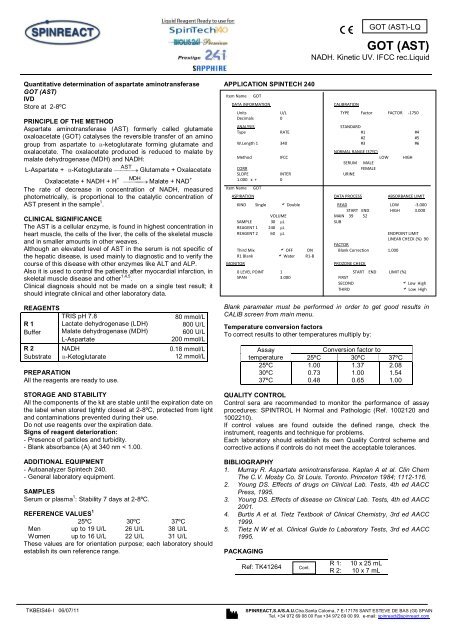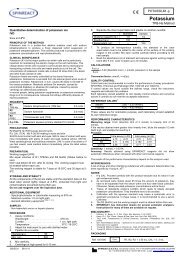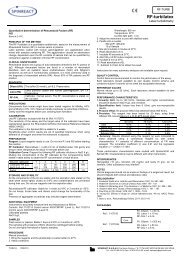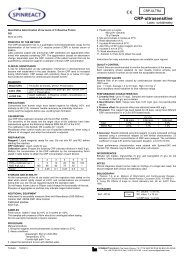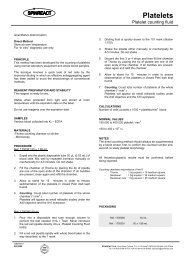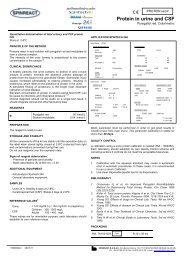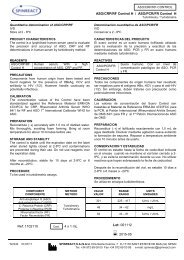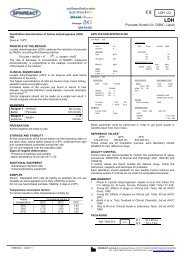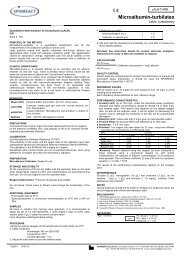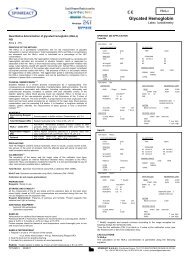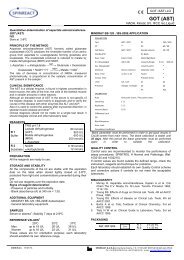GOT (AST)
GOT (AST) - Spinreact
GOT (AST) - Spinreact
- No tags were found...
Create successful ePaper yourself
Turn your PDF publications into a flip-book with our unique Google optimized e-Paper software.
<strong>GOT</strong> (<strong>AST</strong>)-LQ<br />
<strong>GOT</strong> (<strong>AST</strong>)<br />
NADH. Kinetic UV. IFCC rec.Liquid<br />
Quantitative determination of aspartate aminotransferase<br />
<strong>GOT</strong> (<strong>AST</strong>)<br />
IVD<br />
Store at 2-8ºC<br />
PRINCIPLE OF THE METHOD<br />
Aspartate aminotransferase (<strong>AST</strong>) formerly called glutamate<br />
oxaloacetate (<strong>GOT</strong>) catalyses the reversible transfer of an amino<br />
group from aspartate to -ketoglutarate forming glutamate and<br />
oxalacetate. The oxalacetate produced is reduced to malate by<br />
malate dehydrogenase (MDH) and NADH:<br />
<strong>AST</strong><br />
L-Aspartate + -Ketoglutarate Glutamate + Oxalacetate<br />
Oxalacetate + NADH + H + MDH Malate + NAD +<br />
The rate of decrease in concentration of NADH, measured<br />
photometrically, is proportional to the catalytic concentration of<br />
<strong>AST</strong> present in the sample 1 .<br />
CLINICAL SIGNIFICANCE<br />
The <strong>AST</strong> is a cellular enzyme, is found in highest concentration in<br />
heart muscle, the cells of the liver, the cells of the skeletal muscle<br />
and in smaller amounts in other weaves.<br />
Although an elevated level of <strong>AST</strong> in the serum is not specific of<br />
the hepatic disease, is used mainly to diagnostic and to verify the<br />
course of this disease with other enzymes like ALT and ALP.<br />
Also it is used to control the patients after myocardial infarction, in<br />
skeletal muscle disease and other 1,4,5 .<br />
Clinical diagnosis should not be made on a single test result; it<br />
should integrate clinical and other laboratory data.<br />
APPLICATION SPINTECH 240<br />
Item Name<br />
<strong>GOT</strong><br />
DATA INFORMATION<br />
CALIBRATION<br />
Units U/L TYPE Factor FACTOR -1750<br />
Decimals 0<br />
ANALYSIS<br />
STANDARD<br />
Type RATE #1 #4<br />
#2 #5<br />
W.Length 1 340 #3 #6<br />
NORMAL RANGE (37ºC)<br />
Method IFCC LOW HIGH<br />
SERUM MALE<br />
CORR<br />
FEMALE<br />
SLOPE INTER URINE<br />
1.000 x + 0<br />
Item Name<br />
<strong>GOT</strong><br />
ASPIRATION DATA PROCESS ABSORBANCE LIMIT<br />
KIND Single Double READ LOW -3.000<br />
START END HIGH 3.000<br />
VOLUME MAIN 39 52<br />
SAMPLE 30 L SUB<br />
REAGENT 1 240 L<br />
REAGENT 2 60 L ENDPOINT LIMIT<br />
LINEAR CHECK (%) 90<br />
FACTOR<br />
Third Mix OFF ON Blank Correction 1.000<br />
R1 Blank Water R1-B<br />
MONITOR<br />
PROZONE CHECK<br />
0 LEVEL POINT 1 START END LIMIT (%)<br />
SPAN 3.000 FIRST<br />
SECOND<br />
Low High<br />
THIRD<br />
Low High<br />
REAGENTS<br />
R 1<br />
Buffer<br />
R 2<br />
Substrate<br />
TRIS pH 7.8<br />
Lactate dehydrogenase (LDH)<br />
Malate dehydrogenase (MDH)<br />
L-Aspartate<br />
NADH<br />
-Ketoglutarate<br />
PREPARATION<br />
All the reagents are ready to use.<br />
80 mmol/L<br />
800 U/L<br />
600 U/L<br />
200 mmol/L<br />
0.18 mmol/L<br />
12 mmol/L<br />
Blank parameter must be performed in order to get good results in<br />
CALIB screen from main menu.<br />
Temperature conversion factors<br />
To correct results to other temperatures multiply by:<br />
Assay<br />
temperature<br />
25ºC<br />
30ºC<br />
37ºC<br />
Conversion factor to<br />
25ºC 30ºC 37ºC<br />
1.00 1.37 2.08<br />
0.73 1.00 1.54<br />
0.48 0.65 1.00<br />
STORAGE AND STABILITY<br />
All the components of the kit are stable until the expiration date on<br />
the label when stored tightly closed at 2-8ºC, protected from light<br />
and contaminations prevented during their use.<br />
Do not use reagents over the expiration date.<br />
Signs of reagent deterioration:<br />
- Presence of particles and turbidity.<br />
- Blank absorbance (A) at 340 nm < 1.00.<br />
ADDITIONAL EQUIPMENT<br />
- Autoanalyzer Spintech 240.<br />
- General laboratory equipment.<br />
SAMPLES<br />
Serum or plasma 1 : Stability 7 days at 2-8ºC.<br />
REFERENCE VALUES 1<br />
25ºC 30ºC 37ºC<br />
Men up to 19 U/L 26 U/L 38 U/L<br />
Women up to 16 U/L 22 U/L 31 U/L<br />
These values are for orientation purpose; each laboratory should<br />
establish its own reference range.<br />
QUALITY CONTROL<br />
Control sera are recommended to monitor the performance of assay<br />
procedures: SPINTROL H Normal and Pathologic (Ref. 1002120 and<br />
1002210).<br />
If control values are found outside the defined range, check the<br />
instrument, reagents and technique for problems.<br />
Each laboratory should establish its own Quality Control scheme and<br />
corrective actions if controls do not meet the acceptable tolerances.<br />
BIBLIOGRAPHY<br />
1. Murray R. Aspartate aminotransferase. Kaplan A et al. Clin Chem<br />
The C.V. Mosby Co. St Louis. Toronto. Princeton 1984; 1112-116.<br />
2. Young DS. Effects of drugs on Clinical Lab. Tests, 4th ed AACC<br />
Press, 1995.<br />
3. Young DS. Effects of disease on Clinical Lab. Tests, 4th ed AACC<br />
2001.<br />
4. Burtis A et al. Tietz Textbook of Clinical Chemistry, 3rd ed AACC<br />
1999.<br />
5. Tietz N W et al. Clinical Guide to Laboratory Tests, 3rd ed AACC<br />
1995.<br />
PACKAGING<br />
Ref: TK41264<br />
Cont.<br />
R 1:<br />
R 2:<br />
10 x 25 mL<br />
10 x 7 mL<br />
TKBEIS46-I 06/07/11<br />
SPINREACT,S.A/S.A.U.Ctra.Santa Coloma, 7 E-17176 SANT ESTEVE DE BAS (GI) SPAIN<br />
Tel. +34 972 69 08 00 Fax +34 972 69 00 99. e-mail: spinreact@spinreact.com
<strong>GOT</strong> (<strong>AST</strong>)-LQ<br />
<strong>GOT</strong> (<strong>AST</strong>)<br />
NADH. Cinético UV. IFCC rec. Líquido<br />
Determinación cuantitativa de aspartato aminotransferasa<br />
<strong>GOT</strong> (<strong>AST</strong>)<br />
IVD<br />
Conservar a 2-8ºC<br />
PRINCIPIO DEL MÉTODO<br />
La aspartato aminotransferasa (<strong>AST</strong>) inicialmente llamada<br />
transaminasa glutamato oxaloacética (<strong>GOT</strong>) cataliza la<br />
transferencia reversible de un grupo amino del aspartato al -<br />
cetoglutarato con formación de glutamato y oxalacetato. El<br />
oxalacetato producido es reducido a malato en presencia de<br />
malato deshidrogenasa (MDH) y NADH:<br />
<strong>AST</strong><br />
L-Aspartato + -Cetoglutarato Glutamato + Oxalacetato<br />
Oxalacetato + NADH + H + MDH Malato + NAD +<br />
La velocidad de disminución de la concentración de NADH en el<br />
medio, determinada fotométricamente, es proporcional a la<br />
concentración catalítica de <strong>AST</strong> en la muestra ensayada 1 .<br />
SIGNIFICADO CLÍNICO<br />
La <strong>AST</strong> es una enzima intracelular, se encuentra en niveles altos<br />
en el músculo del corazón, las células del hígado, las células del<br />
músculo esquelético y en menores cantidades en otros tejidos.<br />
Aunque un nivel elevado de <strong>AST</strong> en suero no es específico de<br />
enfermedad hepática se emplea principalmente para su<br />
diagnóstico y seguimiento, junto con otras enzimas como la ALT<br />
y ALP. También se emplea en el control post-infarto, en pacientes<br />
con desórdenes del músculo esquelético, y en otras<br />
afecciones 1,4,5 .<br />
El diagnóstico clínico debe realizarse teniendo en cuenta todos<br />
los datos clínicos y de laboratorio.<br />
REACTIVOS<br />
R 1<br />
Tampón<br />
R 2<br />
Substrato<br />
TRIS pH 7,8<br />
Lactato deshidrogenasa (LDH)<br />
Malato deshidrogenasa (MDH)<br />
L-Aspartato<br />
NADH<br />
-Cetoglutarato<br />
PREPARACIÓN<br />
Todos los reactivos están listos para su uso.<br />
80 mmol/L<br />
800 U/L<br />
600 U/L<br />
200 mmol/L<br />
0,18 mmol/L<br />
12 mmol/L<br />
CONSERVACIÓN Y ESTABILIDAD<br />
Todos los componentes del kit son estables, hasta la fecha de<br />
caducidad indicada en la etiqueta, cuando se mantienen los<br />
frascos bien cerrados a 2-8ºC, protegidos de la luz y se evita su<br />
contaminación.<br />
No usar reactivos fuera de la fecha indicada.<br />
Indicadores de deterioro de los reactivos:<br />
- Presencia de partículas y turbidez.<br />
- Absorbancias del Blanco a 340 < 1,00.<br />
MATERIAL ADICIONAL<br />
- Autoanalizador Spintech 240.<br />
- Equipamiento habitual de laboratorio.<br />
MUESTRAS<br />
Suero o plasma 1 . Estabilidad de la muestra: 7 días a 2-8ºC.<br />
VALORES DE REFERENCIA 1<br />
25ºC 30ºC 37ºC<br />
Hombres Hasta 19 U/L 26 U/L 38 U/L<br />
Mujeres Hasta 16 U/L 22 U/L 31 U/L<br />
Estos valores son orientativos. Es recomendable que cada<br />
laboratorio establezca sus propios valores de referencia.<br />
APLICACIÓN AL SPINTECH 240<br />
Item Name<br />
<strong>GOT</strong><br />
DATA INFORMATION<br />
Es necesario solicitar el blanco en este parámetro para obtener<br />
resultados correctos en la pantalla principal de CALIB.<br />
Factores de conversión de temperaturas<br />
Los resultados pueden transformarse a otras temperaturas<br />
multiplicando por:<br />
Temperatura<br />
de medición<br />
25ºC<br />
30ºC<br />
37ºC<br />
Factor para convertir a<br />
25ºC 30ºC 37ºC<br />
1,00 1,37 2,08<br />
0,73 1,00 1,54<br />
0,48 0,65 1,00<br />
CONTROL DE CALIDAD<br />
Es conveniente analizar junto con las muestras sueros control<br />
valorados: SPINTROL H Normal y Patológico (Ref. 1002120 y<br />
1002210).<br />
Si los valores hallados se encuentran fuera del rango de tolerancia,<br />
revisar el instrumento, los reactivos y el calibrador.<br />
Cada laboratorio debe disponer su propio Control de Calidad y<br />
establecer correcciones en el caso de que los controles no cumplan<br />
con las tolerancias.<br />
BIBLIOGRAFÍA<br />
1. Murray R. Aspartate aminotransferase. Kaplan A et al. Clin Chem<br />
The C.V. Mosby Co. St Louis. Toronto. Princeton 1984; 1112-116.<br />
2. Young DS. Effects of drugs on Clinical Lab. Tests, 4th ed AACC<br />
Press, 1995.<br />
3. Young DS. Effects of disease on Clinical Lab. Tests, 4th ed AACC<br />
2001.<br />
4. Burtis A et al. Tietz Textbook of Clinical Chemistry, 3rd ed AACC<br />
1999.<br />
5. Tietz N W et al. Clinical Guide to Laboratory Tests, 3rd ed AACC<br />
1995.<br />
PRESENTACIÓN<br />
Ref: TK41264<br />
Cont.<br />
CALIBRATION<br />
Units U/L TYPE Factor FACTOR -1750<br />
Decimals 0<br />
ANALYSIS<br />
STANDARD<br />
Type RATE #1 #4<br />
#2 #5<br />
W.Length 1 340 #3 #6<br />
NORMAL RANGE (37ºC)<br />
Method IFCC LOW HIGH<br />
SERUM MALE<br />
CORR<br />
FEMALE<br />
SLOPE INTER URINE<br />
1.000 x + 0<br />
Item Name<br />
<strong>GOT</strong><br />
ASPIRATION DATA PROCESS ABSORBANCE LIMIT<br />
KIND Single Double READ LOW -3.000<br />
START END HIGH 3.000<br />
VOLUME MAIN 39 52<br />
SAMPLE 30 L SUB<br />
REAGENT 1 240 L<br />
REAGENT 2 60 L ENDPOINT LIMIT<br />
LINEAR CHECK (%) 90<br />
FACTOR<br />
Third Mix OFF ON Blank Correction 1.000<br />
R1 Blank Water R1-B<br />
MONITOR<br />
PROZONE CHECK<br />
0 LEVEL POINT 1 START END LIMIT (%)<br />
SPAN 3.000 FIRST<br />
SECOND<br />
Low High<br />
THIRD<br />
Low High<br />
R 1:<br />
R 2:<br />
10 x 25 mL<br />
10 x 7 mL<br />
TKBEIS46-E 06/07/11 SPINREACT,S.A/S.A.U. Ctra.Santa Coloma, 7 E-17176 SANT ESTEVE DE BAS (GI) SPAIN<br />
Tel. +34 972 69 08 00 Fax +34 972 69 00 99. e-mail: spinreact@spinreact.com


